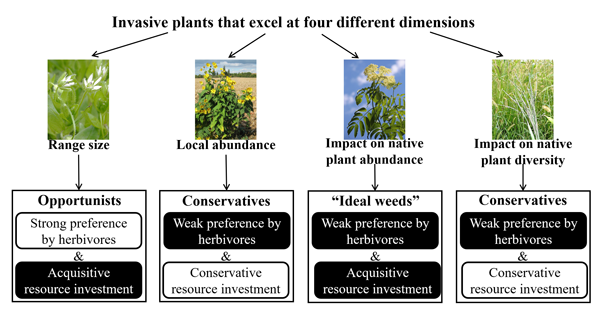Prof. Shaolin Peng’s team from the School of Life Sciences discover functional-characteristics-dependency of different dimensions of plant invasiveness
Source: School of Life Sciences
Edited by: Tan Rongyu, Wang Dongmei
Understanding the mechanisms affecting plant invasiveness is fundamental for biocontrol of invasive plants, which has received more and more attention in the recent decades. A recent study entitled “Different functional characteristics can explain different dimensions of plant invasion success” by Prof. Shaolin Peng’s team from the School of Life Sciences at Sun Yat-sen University proposes a comprehensive research framework for future studies on exotic plant invasion to separate different dimensions of plant invasion and explore the functional characteristics associated with these different dimensions.
In this study, a dataset of leaf traits and four dimensions of invasion success (i.e., range size, local abundance, impact on native plant abundance, and impact on native plant diversity) were compiled for 395 non-native plant species in the US and Europe to explore associations between leaf traits and dimensions. According to the results, different dimensions of invasion success did not always covary; and they were associated with different functional traits (Fig. 1). Invasion success at the regional scale was related to traits that promote rapid colonization; whereas invasion success at the local scale was related to traits that are potentially less preferred by herbivores. There was only one category where successful invaders met our expectation of “ideal weeds”, and that was where they have a strong impact on native plant abundance. Some locally successful invaders even possessed traits that facilitate a high stress tolerance and conservative strategy, which were similar to locally abundant native species.

Fig. 1. Summary of the key findings of the current study. The species from left to right are
Stellaria media (Caryophyllaceae),
Helianthus tuberosus (Asteraceae),
Sambucus canadensis (Adoxaceae) and
Panicum dichotomiflorum (Poaceae), which are the invaders with the largest values for those corresponding dimensions. The characteristics that are reported to benefit invasion are shown in black boxes, while those that may hinder invasion are shown in white boxes.
This study indicates that the inconsistencies in the mechanisms affecting the success of different invaders may partly arise from the confusion in how “invasion success” is defined. Ignoring apparent distinctions among different dimensions can lead to confusing and inconsistent conclusions about plant invasion. Therefore, this study highlights the importance of separately studying different dimensions of invasion success in the future, which could benefit both theoretic studies and practices on biocontrol of invasive plants.
This study was published in J
ournal of Ecology (IF=5.762, JCR=Q1) under the corporation between scientists from China, USA, Italy, Austria and Estonia. It is supported by National Natural Science Foundation of China. Prof. Shaolin Peng is the corresponding author. Dr. Huixuan Liao and Dr. Robert Pal (Montana Technological University, USA) are the joint first authors.
Link to the paper:
https://besjournals.onlinelibrary.wiley.com/doi/10.1111/1365-2745.13575
